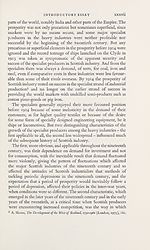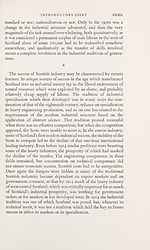Series 4 > Scottish industrial history
(43) Page xxxviii
Download files
Complete book:
Individual page:
Thumbnail gallery: Grid view | List view

xxxviii SCOTTISH INDUSTRIAL HISTORY
some major Scottish industries, and in particular some major
Scottish firms, became so dependent on demand for their products
from the public sector that their continued prosperity was a by¬
product of public policy, which had a variability all its own. The
best example lies in the dependence of some shipbuilding firms on
the Clyde on Admiralty orders. Of thirty-nine launches from John
Brown’s between 1908 and the outbreak of war, twenty-one were
naval vessels.
When the modern Scottish industrial structure was being formed
in the eighteenth century its progress depended on agricultural
improvements; when it was established its continued prosperity
rested on overseas demand, and latterly on demand for investment
goods, again much of it from overseas or from the public sector.
Until 1918 these characteristics produced few immediate problems,
but they placed much of Scottish industry in a precarious position
for the future. The qualities which the heavy industrial bias lacked
are equally obvious, though any regret at failure of industrial
growth in other fields became a matter of concern only when the
earlier basis of expansion collapsed. The specialist form of industrial
production was not geared towards the industries based on scientific
knowledge, not towards light industry, and not towards the
domestic consumer market. The Albion Company, the one lasting
success in car manufacture in pre-1914 days, specialised in the
manufacture of commercial vehicles from 1913. Some of the earliest
ventures into the new industrial fields came from foreign enterprise:
Nobel at Ardeer in 1873; Singer’s at Glasgow, then at Clydebank
in the 1880s. Perhaps the most important of all, was the lack of a
light machine tools industry with its pervasive influence on growth
throughout industry. The weight of the Scottish industrialist
tradition - specialist or generalist - was against such growth, and
before 1914 there was apparently no need for it.
Like so much else, the prosperity of Scottish industry was never
the same after 1918, because after the immediate post-war boom,
the basis of the prosperity of the skilled specialists was removed. It
was some time after 1918 before the need for any change in direction
of industrial growth was recognised. The industrial collapse was
recognised, but the cures were to be found in whatever nostrum
pleased the individual: wage cuts or not; the adoption of the gold
some major Scottish industries, and in particular some major
Scottish firms, became so dependent on demand for their products
from the public sector that their continued prosperity was a by¬
product of public policy, which had a variability all its own. The
best example lies in the dependence of some shipbuilding firms on
the Clyde on Admiralty orders. Of thirty-nine launches from John
Brown’s between 1908 and the outbreak of war, twenty-one were
naval vessels.
When the modern Scottish industrial structure was being formed
in the eighteenth century its progress depended on agricultural
improvements; when it was established its continued prosperity
rested on overseas demand, and latterly on demand for investment
goods, again much of it from overseas or from the public sector.
Until 1918 these characteristics produced few immediate problems,
but they placed much of Scottish industry in a precarious position
for the future. The qualities which the heavy industrial bias lacked
are equally obvious, though any regret at failure of industrial
growth in other fields became a matter of concern only when the
earlier basis of expansion collapsed. The specialist form of industrial
production was not geared towards the industries based on scientific
knowledge, not towards light industry, and not towards the
domestic consumer market. The Albion Company, the one lasting
success in car manufacture in pre-1914 days, specialised in the
manufacture of commercial vehicles from 1913. Some of the earliest
ventures into the new industrial fields came from foreign enterprise:
Nobel at Ardeer in 1873; Singer’s at Glasgow, then at Clydebank
in the 1880s. Perhaps the most important of all, was the lack of a
light machine tools industry with its pervasive influence on growth
throughout industry. The weight of the Scottish industrialist
tradition - specialist or generalist - was against such growth, and
before 1914 there was apparently no need for it.
Like so much else, the prosperity of Scottish industry was never
the same after 1918, because after the immediate post-war boom,
the basis of the prosperity of the skilled specialists was removed. It
was some time after 1918 before the need for any change in direction
of industrial growth was recognised. The industrial collapse was
recognised, but the cures were to be found in whatever nostrum
pleased the individual: wage cuts or not; the adoption of the gold
Set display mode to:
![]() Universal Viewer |
Universal Viewer | ![]() Mirador |
Large image | Transcription
Mirador |
Large image | Transcription
Images and transcriptions on this page, including medium image downloads, may be used under the Creative Commons Attribution 4.0 International Licence unless otherwise stated. ![]()
| Scottish History Society volumes > Series 4 > Scottish industrial history > (43) Page xxxviii |
|---|
| Permanent URL | https://digital.nls.uk/126655527 |
|---|
| Description | Over 180 volumes, published by the Scottish History Society, containing original sources on Scotland's history and people. With a wide range of subjects, the books collectively cover all periods from the 12th to 20th centuries, and reflect changing trends in Scottish history. Sources are accompanied by scholarly interpretation, references and bibliographies. Volumes are usually published annually, and more digitised volumes will be added as they become available. |
|---|


